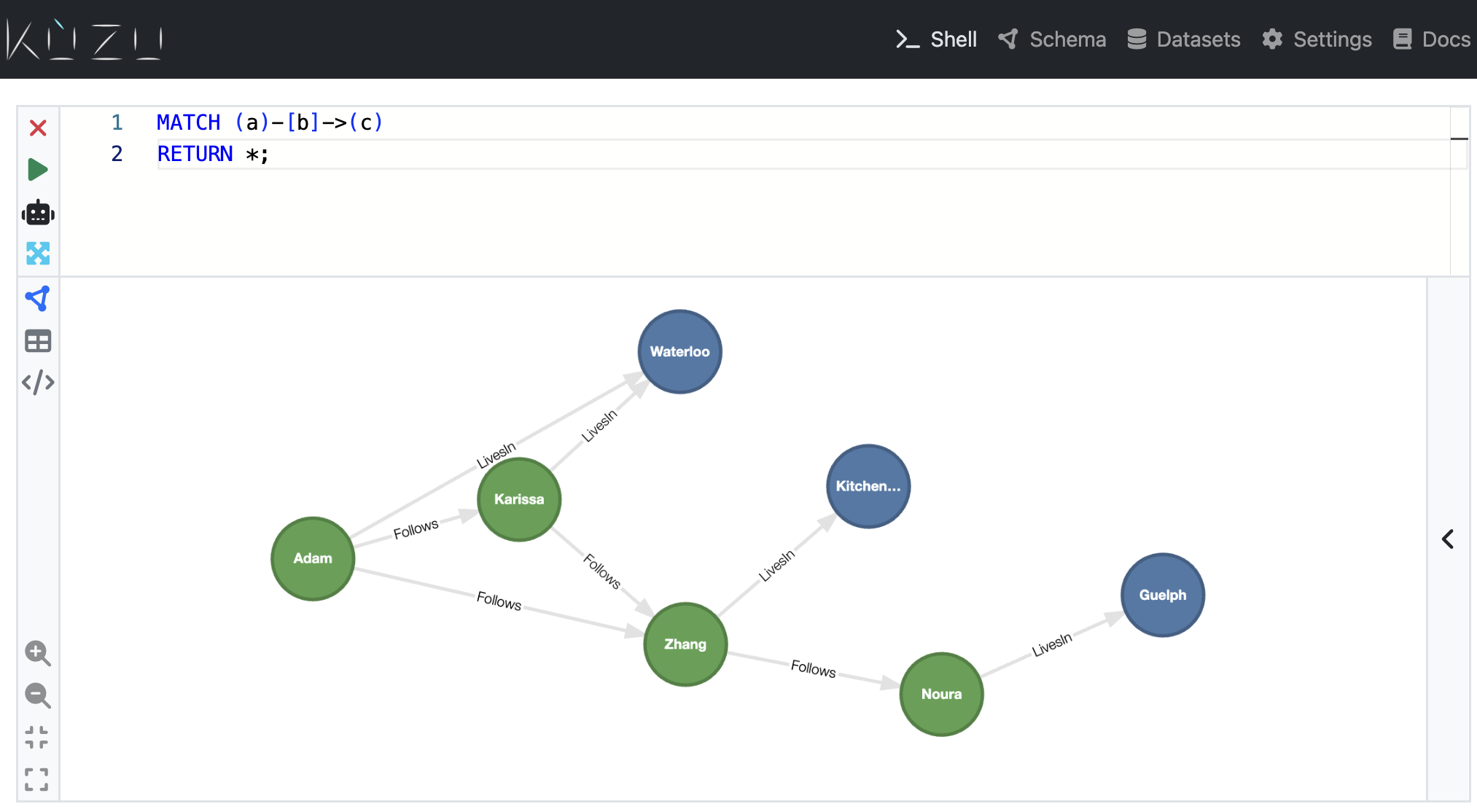Query & visualize your graph
Cypher is a declarative query language for graphs, and should be simple to read and write for anyone who is familiar with SQL. Kuzu’s implementation of Cypher is based on the openCypher standard.
This section will briefly cover how to use Cypher to query the graph created in the previous section. For a detailed guide on using Cypher in Kuzu and to see all the available functions, see the Cypher manual.
Query interfaces
There are three ways you can query an existing Kuzu database:
- CLI: Write Cypher queries directly in the Kuzu CLI shell
- Kuzu Explorer: Interactively write and run Cypher queries using Kuzu Explorer, a web-based query interface that also provides graph visualization
- Client API: Integrate Kuzu with your application in your preferred programming language
Cypher introduction
For simplicity, we’ll demonstrate how to run Cypher queries in this section using Kuzu Explorer — though you are welcome to run the queries via the CLI or your preferred client language API.
The advantage of using Kuzu Explorer to run queries during the prototyping and exploration phase is that you can visualize the graph as you query it. Additionally, you can also view the query results as a table or as JSON, allowing you to easily design your application logic.
Open database in Kuzu Explorer
Run the appropriate version of Kuzu Explorer via Docker as follows:
docker run -p 8000:8000 \ -v /absolute/path/to/demo_db:/database \ --rm kuzudb/explorer:latestVisualize nodes and rels
The simplest Cypher query one can write is to display all nodes and rels, regardless of the table
name, using a MATCH statement as follows:
MATCH (a)-[b]->(c)RETURN *;
Of course, this is a sample graph with only a few nodes/rels. In a real-world scenario, you
would likely limit the number of nodes/rels returned by using the LIMIT clause.
MATCH (a)-[b]->(c)RETURN * LIMIT 10;Match nodes of a particular label
You can match on a particular node label using its table name as shown below:
MATCH (a:User) RETURN a.name AS name, a.age AS age;Note how the name and age properties are aliased in the RETURN statement.
This returns the following result:
| name | age |
|---|---|
| Adam | 30 |
| Karissa | 40 |
| Zhang | 50 |
| Noura | 25 |
Match relationships of a particular label
Similarly, you can match on a particular relationship label using its table name as shown below:
MATCH (a)-[e:Follows]->(b) RETURN e.*;This returns the following result:
| user1 | user2 | follows_since |
|---|---|---|
| Adam | Karissa | 2020 |
| Adam | Zhang | 2020 |
| Karissa | Zhang | 2021 |
| Zhang | Noura | 2022 |
Match with equality predicates on node/rel properties
MATCH (a:User)-[e:Follows {since: 2020}]->(b:User {name: "Karissa"})RETURN b.name AS user, a.name AS follower, e.since AS follows_since;This returns:
| user | follower | follows_since |
|---|---|---|
| Karissa | Adam | 2020 |
Note that the predicates on properties are enclosed in curly braces {}. This is functionally equivalent
to using a WHERE clause in Cypher. The following query would return the same result:
MATCH (a:User)-[e:Follows]->(b:User)WHERE e.since = 2020 AND b.name = "Karissa"RETURN b.name AS user, a.name AS follower, e.since AS follows_since;Cypher tutorial
The following tutorial covers the basics of Cypher in much greater depth. You can work with it Python by launching the Google Colab notebook in your browser.

